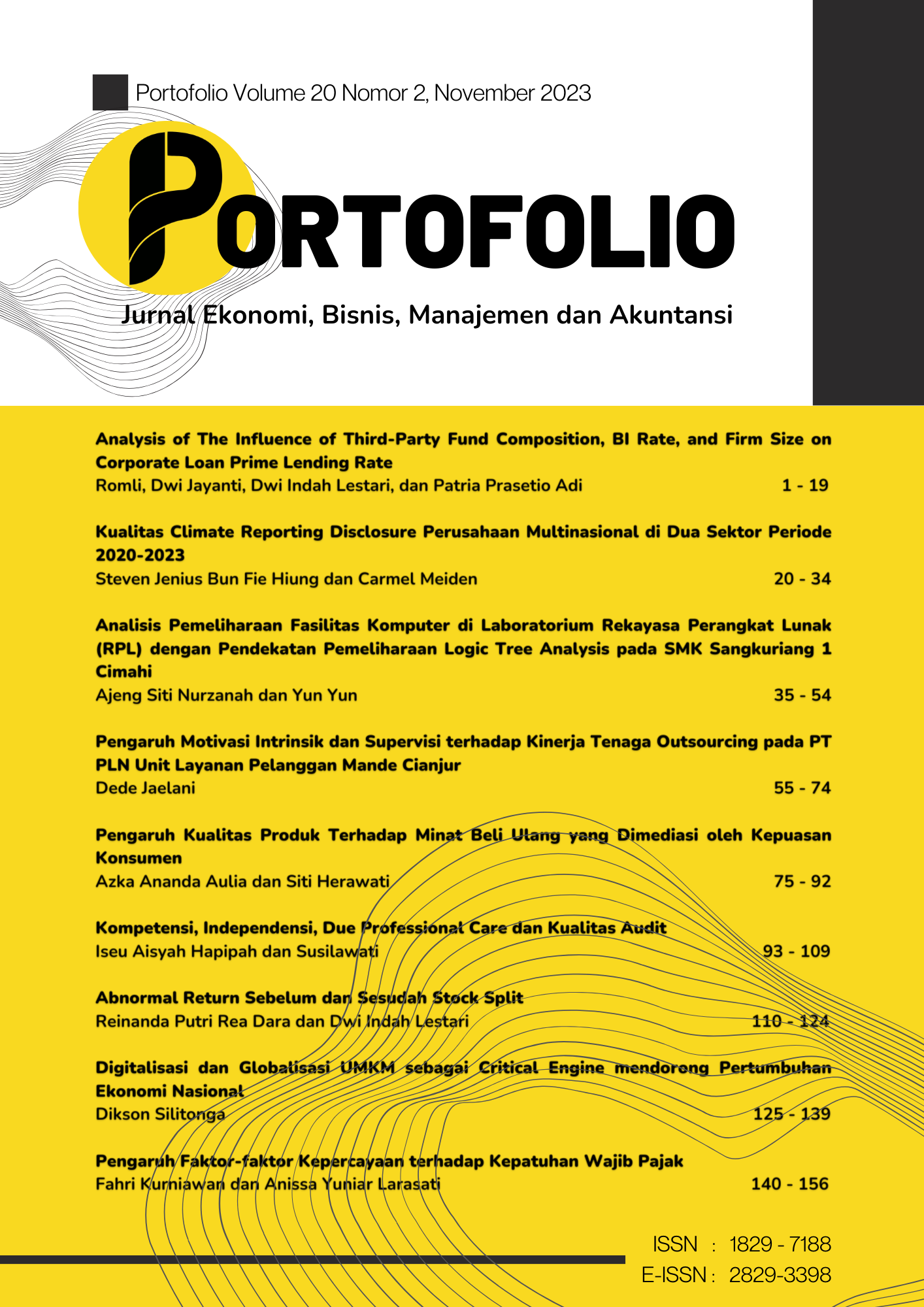Analysis of the Influence of Third Party Fund Composition, BI Rate, and Firm Size on Corporate Loan Prime Lending Rate
Abstract
Abstract
The purpose of this study is to ascertain if the basic credit interest rate (SBDK) for corporate credit in banking businesses listed on the Indonesia Stock Exchange in 2018–2021 is influenced by the TPF composition, the BI-7 Day Reverse Repo Rate (BI Rate), and the size of the company. This study employed secondary data for its data collection. Publications representing the completed version of the data are acquired. Regression coefficient research indicates that the factors related to current accounts and business size are negative, but the variables related to savings, deposits, and BI Rate are positive. Joint hypothesis testing results indicate that the basic credit interest rate is influenced by the size of the company, the BI Rate, and the makeup of third-party funds. The basic credit interest rate is influenced by the BI Rate and company size, but not by the makeup of third-party funds. The value of R square is 0.271. This demonstrates how the BI Rate, the size of the company, and the makeup of third-party funds affect the basic credit interest rate by 27.1%, with other factors influencing the remaining amount.
Abstrak
Penelitian ini bertujuan untuk mengetahui apakah komposisi DPK, BI-7 Day Reverse Repo Rate (BI Rate), dan ukuran perusahaan berpengaruh terhadap suku bunga dasar kredit (SBDK) kredit korporasi pada perusahaan perbankan yang terdaftar di Bursa Efek Indonesia. pada tahun 2018 – 2021. Data yang digunakan dalam penelitian ini adalah data sekunder. Data yang diperoleh sudah dalam bentuk jadi berupa publikasi. Hasil penelitian koefisien regresi variabel transaksi berjalan dan ukuran perusahaan bernilai negatif, sedangkan variabel tabungan, deposito dan BI Rate bernilai positif. Hasil pengujian hipotesis bersama menunjukkan bahwa komposisi dana pihak ketiga, BI Rate, dan ukuran perusahaan berpengaruh terhadap suku bunga dasar kredit. Secara parsial BI Rate dan ukuran perusahaan berpengaruh terhadap suku bunga dasar kredit, sedangkan komposisi dana pihak ketiga tidak berpengaruh. Nilai R square sebesar 0,271. Hal ini menunjukkan bahwa komposisi dana pihak ketiga, BI Rate, dan ukuran perusahaan berpengaruh terhadap suku bunga dasar kredit sebesar 27,1% sedangkan sisanya dipengaruhi oleh faktor lain.
References
Adawiyah, A.Z. (2017). The Influence of Capital, Assets and Company Size on Banking Profitability. Journal of Management Research, 6, 1–15.
Cashmere. (2014). Basics of Banking (Revised) (Revised). PT. Raja Grafindo Persada.
Cashmere. (2015). Banking Management (Revised) (Revised). PT. Raja Grafindo Persada.
De Porter, Bobbi dan Hernacki, Mike. 1992. Quantum Learning. Membiasakan Belajar Nyaman dan Menyenangkan. Terjemahan oleh Alwiyah Abdurrahman. Bandung: Penerbit Kaifa.
Financial Services Authority. (2022). Basic Credit Interest Rate. Www.Ojk.Go.Id. https://www.ojk.go.id/id/kanal/perbankan/Pages/Suku-Bunga-Dasar.aspx
Haryono, E. (2021). BI-7 Day Reverse Repo Rate 3.5%: Synergy to Maintain Stability and Strengthen Recovery. Www.Bi.Go.Id. https://www.bi.go.id/id/publikasi/ruang-media/news-release/Pages/sp_2333221.aspx
Herdaru Purnomo & Hidayat Setiaji. (2021). BI Goes Down the Mountain, Banks Must Open Up About Credit Interest! Www.Cnbcindonesia.Com. https://www.cnbcindonesia.com/market/20210128110444-17-219346/bi-turun-gunung-bank-wajib-buka-bukaan-soal-bunga-kredit/2
Iskandar. (2009). Qualitative Research Methodology. Gaung Persada (GP Press).
Leon, B. and S.E. (2008). Non-Foreign Exchange Bank Liability Asset Management. PT Grasindo.
Muljono. (2006). Tax Accounting. Erlangga.
Rivai, V. (2007). Bank and Financial Institute Management. PT. Raja Grafindo Persada.
Sugiyono. (2016). Quantitative, Qualitative and R&D Research Methods. Alphabet PT.
Sugiyono. (2017). Quantitative, Qualitative, R&D research methods. Alphabet PT.
Sujimat, D. Agus. 2000. Penulisan karya ilmiah. Makalah disampaikan pada pelatihan penelitian bagi guru SLTP Negeri di Kabupaten Sidoarjo tanggal 19 Oktober 2000 (Tidak diterbitkan). MKKS SLTP Negeri Kabupaten Sidoarjo
Suparno. 2000. Langkah-langkah Penulisan Artikel Ilmiah dalam Saukah, Ali dan Waseso, M.G. 2000. Menulis Artikel untuk Jurnal Ilmiah. Malang: UM Press.
UNESA. 2000. Pedoman Penulisan Artikel Jurnal, Surabaya: Lembaga Penelitian Universitas Negeri Surabaya.
Wahab, Abdul dan Lestari, Lies Amin. 1999. Menulis Karya Ilmiah. Surabaya: Airlangga University Press.
Winardi, Gunawan. 2002. Panduan Mempersiapkan Tulisan Ilmiah. Bandung: Akatiga.
Copyright (c) 2023 Romli Romli

This work is licensed under a Creative Commons Attribution-ShareAlike 4.0 International License.
Authors who publish in Portfolio: Jurnal Ekonomi, Bisnis, Manajemen, dan Akuntansi agree to the following terms:
- Authors retain copyright and grant the journal right of first publication with the work simultaneously licensed under a Attribution-ShareAlike 4.0 International (CC BY-SA 4.0) License that allows others to share the work with an acknowledgment of the work's authorship and initial publication in this journal.
- Authors are able to enter into separate, additional contractual arrangements for the non-exclusive distribution of the journal's published version of the work (e.g., post it to an institutional repository or publish it in a book), with an acknowledgment of its initial publication in this journal.
- Authors are permitted and encouraged to post their work online (e.g., in institutional repositories or on their website) prior to and during the submission process, as it can lead to productive exchanges, as well as earlier and greater citation of published work (See The Effect of Open Access).


1.png)






